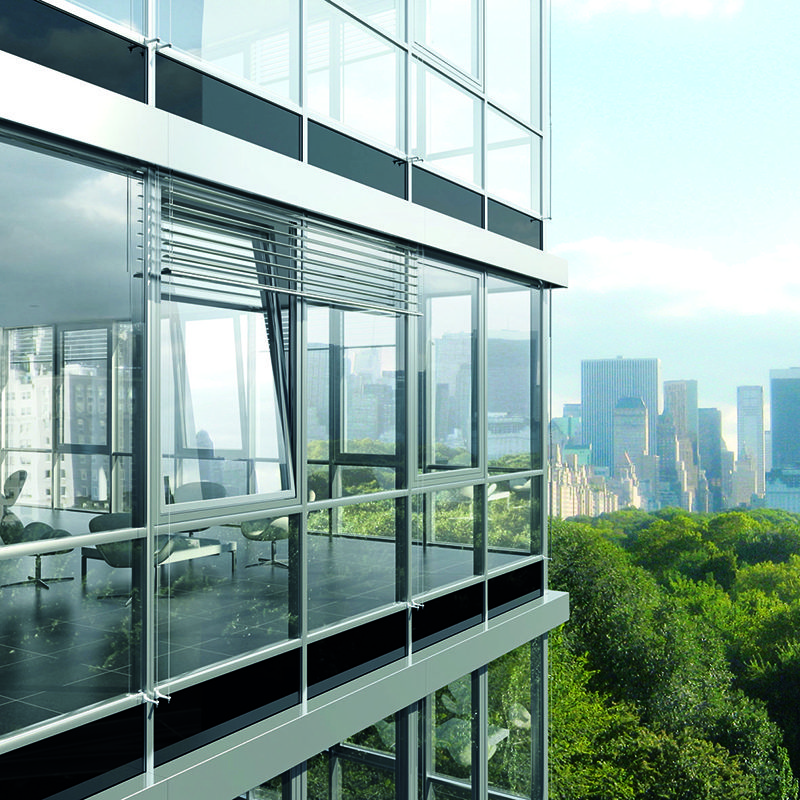Danny Fitzgerald, National Architectural Manager at Schüco UK, in conversation with Architecture Today’s Technical Editor John Ramshaw, discusses the increasingly important role Cradle to Cradle design and certification is playing in the manufacture and use of the company’s facade, window and door systems.
The Schüco FWS 50.SI (super insulated) façade system has been awarded the Silver Cradle-to-Cradle Certified sustainability label by the independent C2CPII institute
Embodied carbon is central to the current environmental debate, and how we operate, adapt and reuse buildings will be key to ensuring a viable sustainable future. With the construction sector thought to be responsible for around half of all material consumption worldwide, it is essential that the industry moves to a circular approach whereby most if not all building components – from the smallest internal fixtures and fittings to whole façades – can be perpetually repurposed and recycled.
Cradle to Cradle design underpins much of the current thinking on the circular economy and has been adopted by several leading manufacturers – not least façade, window and door systems specialist Schüco. Danny Fitzgerald, National Architectural Manager at Schüco UK, in conversation with Architecture Today’s Technical Editor John Ramshaw, discusses how the company has incorporated this innovative design philosophy into its manufacturing operation and what this means for its products and the buildings they are specified on.
What is Cradle to Cradle and how has Schüco incorporated it into their approach?
The Cradle to Cradle philosophy is central to circular product developments at Schüco. Cradle to Cradle certified confirms successful testing of the product quality by the Cradle to Cradle Products Innovation Institute (C2CPII). Schüco and our suppliers provide the necessary information about the product manufacture in five important areas: material health of substances used, recyclability of the product in the technical or biological cycle, use of renewable energies, responsible water management, and adherence to social standards.
All five criteria are weighted equally, however material health is given particular importance. If a material contains substances on a banned list, it will not be granted certification. One of five certification levels can be achieved in each assessment area: Basic, Bronze, Silver, Gold, or Platinum. The results are recorded on a scorecard, with the overall result based on the weakest criterion assessed.
How important is the Cradle to Cradle certification scheme?
The building sector accounts for around half of material consumption worldwide. We should use this fact as an opportunity to innovate and drive forward the development of products that are truly recyclable. C2C-certified products are viewed positively by the LEED green building rating system, and the certification can be used as a supporting document in conjunction with many other green building standards.
Does Cradle to Cradle certification apply to individual components and/or whole façade systems?
C2C applies to individual systems but includes windows and doors, as well as façades. Schüco achieved Bronze C2C certification for its modular system back in 2016. This means that certified articles can be used to put together an entire production line with the C2C Bronze standard.
Today, the company has 48 systems with Silver certification and nine with Bronze across all of our system ranges, from windows and doors to facades and sun control systems. All our C2C-certified systems are available as standard at no additional cost. Furthermore, C2C-inspired buildings can potentially retain their value better than conventional ones.
Constructed solely in line with the Cradle-to-Cradle philosophy, Kada Wittfeld Architektur’s RAG headquarters in Essen, Germany, incorporates the Schüco AWS 75.SI+ aluminium window system (photo: Nikolai Benner).
How are Schüco products and systems being engineered and manufactured to benefit the circular economy?
A great example of this can be found in the new UDC80 unitised façade system, which uses screw-fix technology to join the aluminium profiles to the plastic components as opposed to rolled in thermal breaks. This means that at the end of the façade’s life, the the two can be easily separated for recycling back into the material cycle chain.
Can individual components and/or whole facade systems be reused and how straightforward is this in practice?
In theory whole façades can be reused, including the glass and aluminium components, but this can only be achieved with careful design from the outset. Generally, façade systems that clamp the glass in place rather than structurally glazed systems are easier to dismantle and reuse.
What is Schüco SchüCal software and how can it help specifiers?
SchüCal introduces the modular system to modern design practice, allowing individual window, door and façade combinations to obtain C2C verification. SchüCal checks all Silver-certified Schüco systems to see whether there is a C2C-compliant configuration. At the touch of a button, it generates environmental product declarations, U-value calculations and CE Declarations of Performance. This gives façade developers and architects complete design freedom and reliability for planning a sustainable building envelope.
Can you tell me how Schüco became involved with the RAG HQ building?
Designed by Kada Wittfeld Architektur, the 9,600-square-metre RAG headquarters in Essen is one of the first buildings in Germany to be constructed solely in line with the Cradle-to-Cradle philosophy. Completed in 2017, the two-storey structure is built from fully recyclable, local materials.
Central to the project is the Schüco Silver-certified AWS 75.SI+ aluminium window system. The individual window units are designed so that they can be fully recycled if the building is demolished or converted, ensuring a zero-waste outcome.
Contact Details
For more information, please call 01908 282111, email or visit the Schüco website.
Source: Architecture Today

